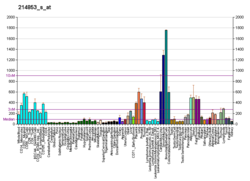Function
Overexpression of SHC proteins are associated with cancer mitogenesis, carcinogenesis and metastasis. [8] The SHC and its adaptor proteins transmit signaling of the cell surface receptors such as EGFR, erbV-2 and insulin receptors. p52SHC and p46SHC activate the Ras-ERK pathway. p66SHC inhibits ERK1/2 activity and antagonize mitogenic and survival abilities of T-lymphoma Jurkat cell lines. [8] A rise in p66SHC promotes stress induced apoptosis. [8] p66SHC functionally is also involved in regulating oxidative and stress- induced apoptosis – mediating steroid action through the redox signaling pathway. P52SHC and p66SHC have been found in steroid hormone-regulated cancer and metastasizes. [8]
EGFR pathway
SHC1 has been found to act in signaling information after epidermal growth factor (EGF) stimulation. Activated tyrosine kinase receptors, on the cell surface, use proteins such as SHC1 that contain phosphotyrosine binding domains. After the EGF stimulation SHC1 binds to groups of proteins that activate survival pathways. This activation is followed by a sub-network of proteins that bind to SHC1 and are involved cytoskeleton reorganization, trafficking and signal termination. PTPN122 then acts as a switch to convert SHC1 to SgK269-mediated pathways that regulate cell invasion and morphogenesis. [7] SHC1 is not a static scaffold protein, a protein that does not move or change over time, it is dynamic as the conformation changes and modifies the EGFR signaling output over time. [10]
MCT-1 regulation
SHC proteins are differentially regulated by the Multiple Copies in T-cell malignancy(MCT-1). This regulation affects the SHC-Ras-ERK pathway. [8] With MCT-1 reduction the phosphor activation of Ras, MEK and ERk ½ were also reduced, this reduction in ERK also affects cyclin D1. The expression of the SHC proteins (all three) were also dramatically reduced with the reduction of MCT-1 because of this it is thought that MCT-1 acts as an inducer of SHC gene transcription. p66SHC is found to be the protein that is most affected by MCT-1. SHC expression downregulated in tumorigenic processes are identified after MCT-1 depletion. By blocking the MCT-1 activity this could inhibit the SHC signaling cascase and the oncogenicty and tumorigenicity that is regulated by SHC expression. [8]
Oxidative stress
Oxidative stress occurs when the production of reactive oxygen species (ROS) is greater than their catabolism. ROS production by the mitochondria is regulated by many diverse factors including SHC1. [11] The SHC proteins are regulated by tyrosine phosphorylation and are part of the growth factor and stress-induced ERK activation. There have been findings that suggest a correlation between life span and the oxidative stress response. Selective resistance to oxidative stress and extended life span have been related to p66SHC. [12]
Life span
There is a link between oxidative stress, life span and p66SHC [12] in mice because of this relationship the SHC gene has been related to longevity and increasing the life span of the mouse. [13] It has been proposed that SHC1 modulates the life span and stress response through the DAF-2 insulin- like receptor of the IIS pathway. The SHC-1 can directly interact with the DAF-2 in vitro. [9]
p66SHC operates as a redox enzyme linked to apoptotic cell death. p66SHC has been related to the sirtuin-1 system and has been associated with endothelial damage and repair. This relationships is also related to vascular homeostasis and oxidative stress. [14] p66SHC can be altered by changes in the glucose metabolism and vascular senescence. When protein kinase C is induced by hyperglycemia, p66SHC is induced which then leads to oxidative stress. When the coagulated protease-activated protein C inhibits p66SHC a cytoprotective effect on diabetic nephropathy is placed on the kidneys . When a mutations such as a p66SHC deletion occurs the cardiomyocyte death is reduced and a pool of cardiac stem cells are preserved from oxidative damage – preventing diabetic cardiomyopathy. The deletion of p66SHC also protects from ischemia/reperfusion brain injuries through blunted production of free radicals. [14]
This page is based on this
Wikipedia article Text is available under the
CC BY-SA 4.0 license; additional terms may apply.
Images, videos and audio are available under their respective licenses.











